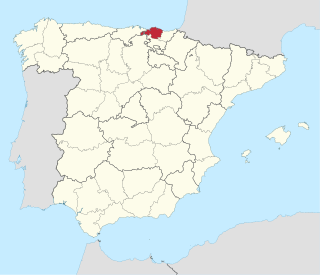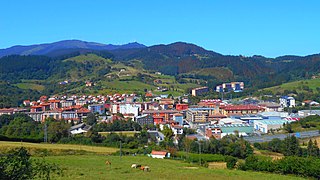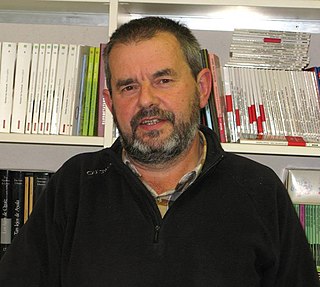
Biscay is a province of Spain, lying on the south shore of the eponymous bay. The name also refers to a historical territory of the Basque Country, heir of the ancient Lordship of Biscay. Its capital city is Bilbao. It is one of the most prosperous and important provinces of Spain as a result of the substantial trading activity of its ports during and after the middle ages, becoming a strong commercial hub, and the massive industrialization during the last quarter of the 19th century and first half of the 20th century, creating one of Spain's largest industrial centers. Since the deep deindustrialization of the 1970s, the economy has come to rely more on the services sector.

Euskotren Trena, formerly known just as Euskotren is a commuter, inter-city and urban transit train-operating company that operates local and inter-city passenger services in the provinces of Biscay and Gipuzkoa, in the Basque Country, Spain. It is one of the four commercial brands under which Euskotren operates, as a public company managed by the Basque government. The entire 181.1-kilometre (112.5 mi) network uses 1,000 mm narrow gauge rail tracks which have been owned by the Basque Government since their transferral from the Spanish government; the rail tracks and stations were part of the FEVE network until its transferral. Euskotren Trena also operates the Donostia/San Sebastián metro under the brand Metro Donostialdea.

Eibar is a city and municipality within the province of Gipuzkoa, in the Basque Country of Spain. It is the head town of Debabarrena, one of the eskualde / comarca of Gipuzkoa.

Gipuzkoa is a province of Spain and a historical territory of the autonomous community of the Basque Country. Its capital city is Donostia-San Sebastián. Gipuzkoa shares borders with the French department of Pyrénées-Atlantiques at the northeast, with the province and autonomous community of Navarre at east, Biscay at west, Álava at southwest and the Bay of Biscay to its north. It is located at the easternmost extreme of the Cantabric Sea, in the Bay of Biscay. It has 66 kilometres of coast land.

Goierri or "Basque Highlands" is one of the eight comarcas in the Spanish province of Gipuzkoa. It is composed of 18 municipalities, Beasain, Ordizia and Lazkao being the main towns. The main administrative center is Beasain.

Anoeta is a town located in the province of Gipuzkoa, in the autonomous community of Basque Country, in the north of Spain.

Azpeitia is a town and municipality within the province of Gipuzkoa, in the Basque Country, Spain, located on the Urola river a few kilometres east of Azkoitia. Its population is 14,580 (2014). It is located 41 kilometres southwest of Donostia/San Sebastián.

Zarautz is a coastal town located in central Gipuzkoa, Basque Country, in Spain. It is bordered by Aia to the east and the south and Getaria to the west, located about 15 kilometres (9.3 mi) west of San Sebastián. It has four enclaves limiting the aforementioned municipalities: Alkortiaga, Ekano, Sola, and Arbestain. As of 2014, Zarautz has a population of 22,890, which usually swells to about 60,000 in the summer.

Atxondo is a municipality located in the province of Biscay, in the Basque Country, Spain. Atxondo is part of the comarca of Durangaldea and has a population of 1,447 inhabitants as of 2007 according to the Spanish National Statistics Institute.

Zaldibar is an elizate, town and municipality located in the province of Biscay, in the Basque Country, Spain. Zaldibar is part of the comarca of Durangaldea and has a population of 3,043 inhabitants as of 2019 and according to the Spanish National Statistics Institute.

San Sebastian, also known as Donostia-San Sebastián is a city and municipality located in the Basque Autonomous Community, Spain. It lies on the coast of the Bay of Biscay, 20 km from the France-Spain border. The capital city of the province of Gipuzkoa, the municipality's population is 188,240 as of 2020, with its metropolitan area reaching 436,500 in 2010. Locals call themselves donostiarra (singular), both in Spanish and Basque. It is also a part of Basque Eurocity Bayonne-San Sebastián.

Basque Y is the high-speed rail network being built between the three cities of the Basque Autonomous Community, in Spain; Bilbao, Vitoria-Gasteiz and Donostia-San Sebastián.
The Aralar Range is a mountain range in the Basque Mountains of Southern Basque Country. The part of the range lying in Gipuzkoa was established as a conservation area called Aralar Natural Park in 1994. In addition to its natural features, scenic beauty, recreational use and habitation, the range is home to a rich corpus of Basque mythology milestones and legends.

The Basque Country, also called Basque Autonomous Community is an autonomous community in northern Spain. It includes the Basque provinces of Álava, Biscay, and Gipuzkoa.
Iñaki Quijera Celarain has died in a demonstration in favor of Basque terrorists. He was 18 when he died, and was living with his parents in the Antiguo district.
Kilometroak is a festival organized every year on the first Sunday of October to reach out to the ikastolas in Gipuzkoa, Basque Country, Spain.

Joxantonio Ormazabal (1948–2010) was a Basque and Spanish author of primarily children's literature in the Basque language. He also published under the pen name of Joxean.

Gladys del Estal Ferreño was a ecologist activist from San Sebastián, Gipuzkoa, Spain. She was killed by a bullet shot at her by the Guardia Civil during a protest in Tudela, Navarre, against the nuclear station construction program for the Basque Country, and the aircraft firing range of Bardenas. She has since become an important icon of the ecologist movement.

Maria Angeles Beitialarrangoitia Lizarralde is a Basque journalist and politician. She was previously a member of the Congress of Deputies of Spain and Basque Parliament, and mayor of Hernani.




















